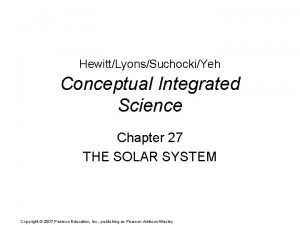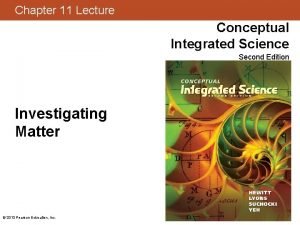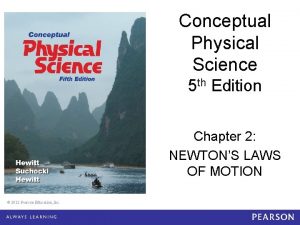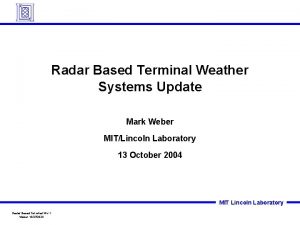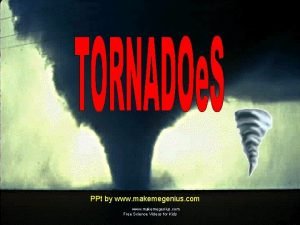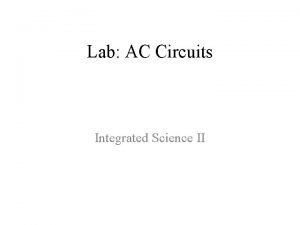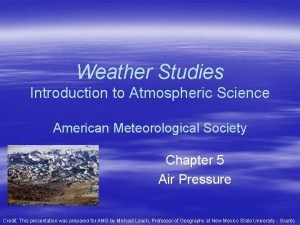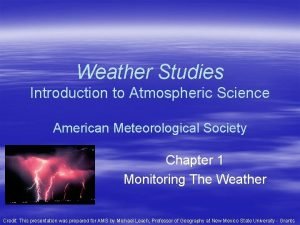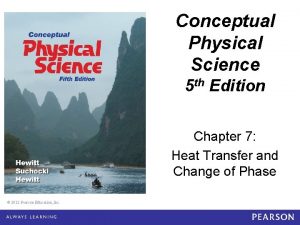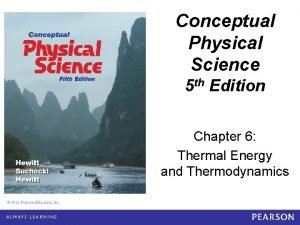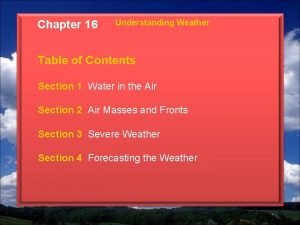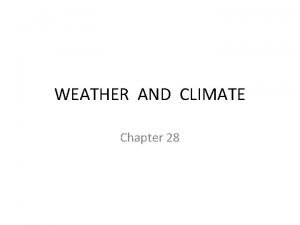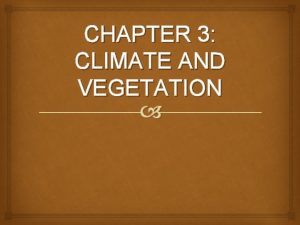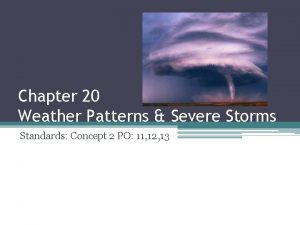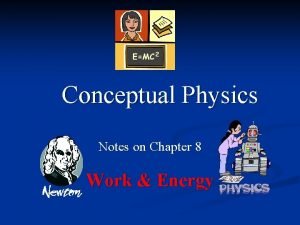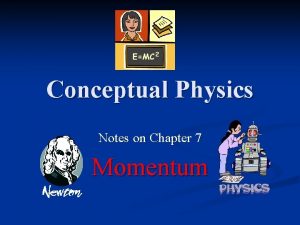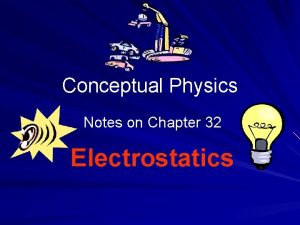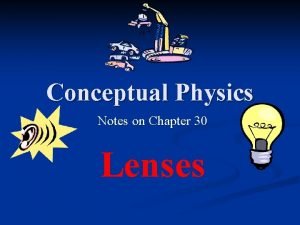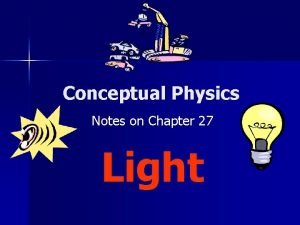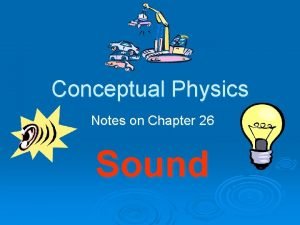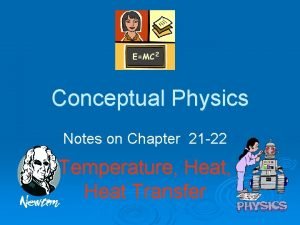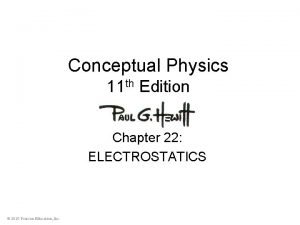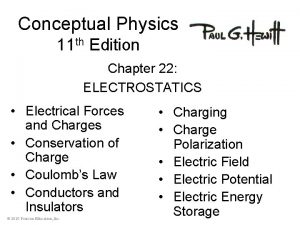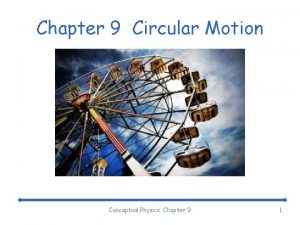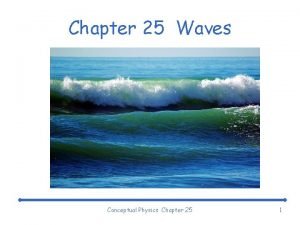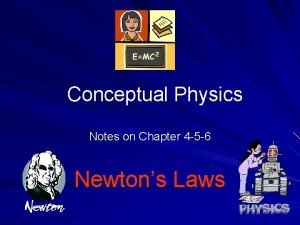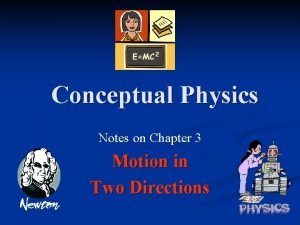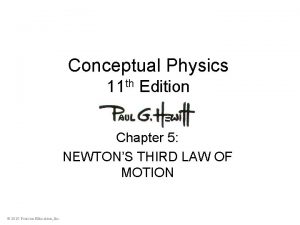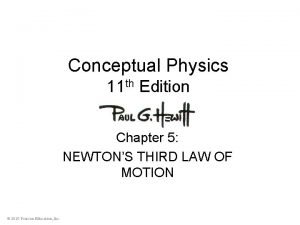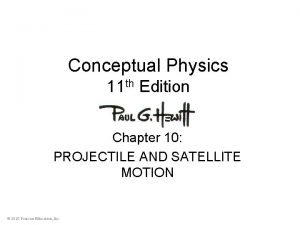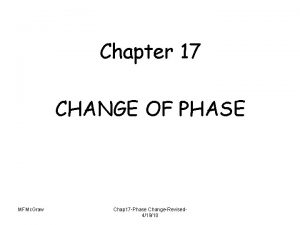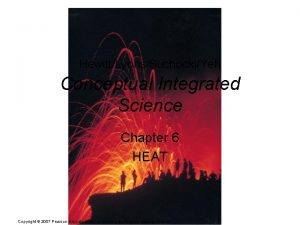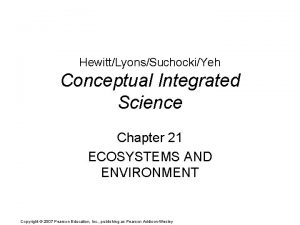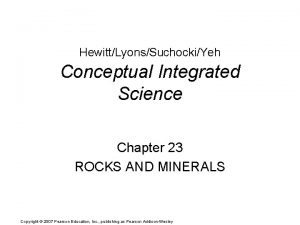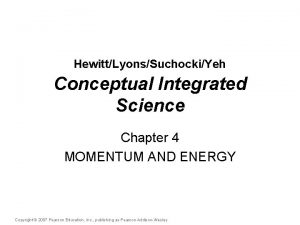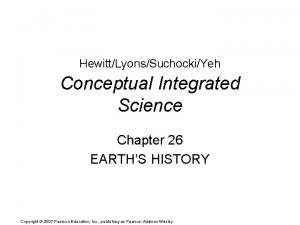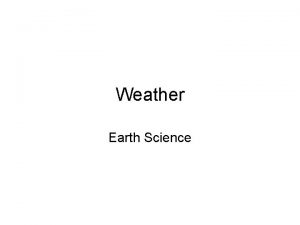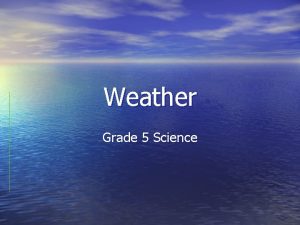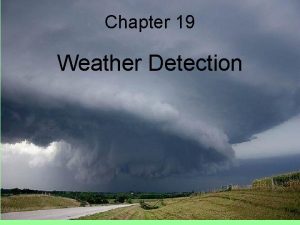HewittLyonsSuchockiYeh Conceptual Integrated Science Chapter 25 WEATHER Copyright


































































- Slides: 66

Hewitt/Lyons/Suchocki/Yeh Conceptual Integrated Science Chapter 25 WEATHER Copyright © 2007 Pearson Education, Inc. , publishing as Pearson Addison-Wesley

This lecture will help you understand: • • • The elements of weather How Earth is warmed from above and below Solar radiation and Earth’s seasons Structure and composition of the atmosphere Why air is more dense at sea level than at higher elevations • Why the winds blow • Atmospheric currents and their influences • Human impact on climate Copyright © 2007 Pearson Education, Inc. , publishing as Pearson Addison-Wesley

Weather and Climate Weather is defined as the state of the atmosphere at a particular time and place. Climate is the general pattern of weather that occurs in a region over a period of years. Weather is short term, climate is long term. Copyright © 2007 Pearson Education, Inc. , publishing as Pearson Addison-Wesley

Weather and Climate Weather is the state of the atmosphere at a particular time and place. The six weather elements include: • • • Atmospheric pressure Temperature Wind Precipitation Cloudiness Humidity Copyright © 2007 Pearson Education, Inc. , publishing as Pearson Addison-Wesley

Weather and Climate The world is divided into different climate zones. Temperatures are: • Highest in the tropics, near the equator • Lower nearer the poles • Moderate and variable in the temperate zone Copyright © 2007 Pearson Education, Inc. , publishing as Pearson Addison-Wesley

Solar Radiation Solar radiation is electromagnetic energy emitted by the Sun. • Visible, short-wavelength radiation Terrestrial radiation is reemitted solar radiation from Earth’s surface. • Infrared, longer-wavelength radiation Copyright © 2007 Pearson Education, Inc. , publishing as Pearson Addison-Wesley

Solar Radiation The Sun warms Earth’s ground, and the ground, in turn, warms Earth’s atmosphere. • Earth’s temperature varies according to the degree of solar intensity—the amount of solar radiation per area. • Where solar intensity is higher, temperatures are higher. Copyright © 2007 Pearson Education, Inc. , publishing as Pearson Addison-Wesley

Solar Radiation Solar intensity is highest where the Sun’s rays strike Earth’s surface straight on. • Flashlight beam at 90° angle to the surface • Equatorial regions Solar intensity is weaker where the Sun’s rays strike Earth’s surface at an angle. • Flashlight beam at an angle • Higher latitudes Copyright © 2007 Pearson Education, Inc. , publishing as Pearson Addison-Wesley

Solar Radiation Variation in solar intensity with latitude and the tilt of the Earth’s axis helps to explain the different seasons. Copyright © 2007 Pearson Education, Inc. , publishing as Pearson Addison-Wesley

Solar Radiation When the Sun’s rays are closest to perpendicular at any spot on the Earth, that region’s season is summer. Six months later, as the rays fall upon the same region more obliquely, the season is winter. In between are the seasons fall and spring. Copyright © 2007 Pearson Education, Inc. , publishing as Pearson Addison-Wesley

Solar Radiation Earth’s revolution (orbit) around the Sun determines the length of a year (365 days). • Earth’s rotation on its axis determines day length— 24 hours in each day. • The number of daylight hours varies during the year depending on latitude. Copyright © 2007 Pearson Education, Inc. , publishing as Pearson Addison-Wesley

Solar Radiation At the summer solstice (June 21 st), locations north of the Arctic Circle in the Northern Hemisphere have ~24 hours of daylight. At the winter solstice (December 22 nd), locations north of the Arctic Circle have ~24 hours of night. In the Southern Hemisphere, it is the Antarctic Circle, and the seasons are reversed (summer solstice is in December). Copyright © 2007 Pearson Education, Inc. , publishing as Pearson Addison-Wesley

Solar Radiation Halfway between the summer and winter solstices are the equinoxes. • Equinox in Latin means “equal nights. ” • Mid-September is the Autumnal (fall) equinox. • Mid-March is the Vernal (spring) equinox. The equal hours of day and night are not restricted to high latitudes but occur all over the world. Copyright © 2007 Pearson Education, Inc. , publishing as Pearson Addison-Wesley

Solar Radiation CHECK YOUR NEIGHBOR On the fourth of July in Kansas City, Missouri, the season is _____. On the fourth of July in Perth, Australia, the season is ______. A. B. C. D. winter; spring summer; fall summer; winter; summer Copyright © 2007 Pearson Education, Inc. , publishing as Pearson Addison-Wesley

Solar Radiation CHECK YOUR ANSWER On the fourth of July in Kansas City, Missouri, the season is _____. On the fourth of July in Perth, Australia, the season is ______. A. B. C. D. winter; spring summer; fall summer; winter; summer Copyright © 2007 Pearson Education, Inc. , publishing as Pearson Addison-Wesley

Solar Radiation CHECK YOUR NEIGHBOR The days are generally longer during the summer than in the winter. How can the number of daylight hours during the summer be about the same in both the Northern and the Southern Hemispheres? A. B. C. D. They aren’t the same. The seasons are the same, but the time of year the season occurs is different. Daylight hours are the same worldwide during the summer. Daylight hours vary with latitude. Copyright © 2007 Pearson Education, Inc. , publishing as Pearson Addison-Wesley

Solar Radiation CHECK YOUR ANSWER The days are generally longer during the summer than in the winter. How can the number of daylight hours during the summer be about the same in both the Northern and the Southern Hemispheres? A. B. C. D. They aren’t the same. The seasons are the same, but the time of year the season occurs is different. Daylight hours are the same worldwide during the summer. Daylight hours vary with latitude. Explanation: The time of the year that the seasons occur is reversed. During the summer, the days are longer in the Northern Hemisphere, and they are longer in the Southern Hemisphere. But the Southern Hemisphere has summer in December. Copyright © 2007 Pearson Education, Inc. , publishing as Pearson Addison-Wesley

Atmospheric Pressure Atmospheric pressure = force the atmosphere exerts on an area of surface. • Force = weight of air molecules above that surface. • At any level in the atmosphere, force = total weight of air above that level. • At higher elevations, fewer air molecules above—atmospheric pressure is less. Copyright © 2007 Pearson Education, Inc. , publishing as Pearson Addison-Wesley

Atmospheric Pressure Copyright © 2007 Pearson Education, Inc. , publishing as Pearson Addison-Wesley

Composition of Atmosphere Copyright © 2007 Pearson Education, Inc. , publishing as Pearson Addison-Wesley

Structure of Atmosphere Earth’s atmosphere is divided into layers, each with different characteristics: • Troposphere • Stratosphere • Mesosphere • Thermosphere • Ionosphere • Exosphere Copyright © 2007 Pearson Education, Inc. , publishing as Pearson Addison-Wesley

Structure of Atmosphere Troposphere: • Lowest and thinnest layer — 16 km at equator, 8 km at poles • 90% of the atmosphere’s mass • Where weather occurs —water vapor and clouds • Temperature decreases with altitude — 6°C per kilometer —Top of troposphere averages – 50°C Copyright © 2007 Pearson Education, Inc. , publishing as Pearson Addison-Wesley

Structure of Atmosphere Stratosphere: • Top of troposphere to 50 km above surface • Ozone layer —Absorbs harmful UV radiation • UV radiation splits O 2 molecules to single O atoms, which collide with O 2 molecules to create ozone, O 3 molecules • Temperature increases because of ozone absorption of UV radiation. —Ranges from – 50°C at base to 0°C at top Copyright © 2007 Pearson Education, Inc. , publishing as Pearson Addison-Wesley

Structure of Atmosphere Mesosphere: • Extends from stratosphere to altitude of 80 km • Temperature decreases with altitude —Gases in this layer absorb very little UV radiation. — 0°C at bottom to – 90°C at top Copyright © 2007 Pearson Education, Inc. , publishing as Pearson Addison-Wesley

Structure of Atmosphere Thermosphere: • No well-defined upper limit • Temperature increases with altitude — Temperature is related to average speed of gas molecules—very high speed gives high temperatures • Very low density of gas molecules means very little heat absorption — Very few air molecules collide with one another—low thermometer reading Copyright © 2007 Pearson Education, Inc. , publishing as Pearson Addison-Wesley

Structure of Atmosphere Ionosphere: • Not a true layer • Electrified region within thermosphere and upper mesosphere —Auroras—fiery displays of light near Earth’s magnetic poles Exosphere: • The interface between Earth and space • Beyond 500 km, atoms and molecules can escape to space Copyright © 2007 Pearson Education, Inc. , publishing as Pearson Addison-Wesley

Structure of Atmosphere Ozone—good and bad: • Stratospheric ozone is good ozone — It facilitated emergence of life on Earth. — It protects Earth from harmful UV radiation. — Stratospheric ozone depletion is detrimental to life. • Tropospheric ozone is bad ozone — In the troposphere, ozone is a pollutant. • CFCs generated by humans (pollutant) spread throughout the atmosphere. — In the stratosphere, CFCs react with “good” ozone and destroy it (ozone depletion). Copyright © 2007 Pearson Education, Inc. , publishing as Pearson Addison-Wesley

Solar Radiation CHECK YOUR NEIGHBOR Atmospheric pressure is greatest near the Earth’s surface because A. B. C. D. of the weight of all the air above. 90% of Earth’s atmosphere is in the troposphere. of warmer temperatures. of water vapor. Copyright © 2007 Pearson Education, Inc. , publishing as Pearson Addison-Wesley

Solar Radiation CHECK YOUR ANSWER Atmospheric pressure is greatest near the Earth’s surface because A. B. C. D. of the weight of all the air above. 90% of Earth’s atmosphere is in the troposphere. of warmer temperatures. of water vapor. Copyright © 2007 Pearson Education, Inc. , publishing as Pearson Addison-Wesley

Solar Radiation CHECK YOUR NEIGHBOR The “ozone hole” is considered to be a problem, because ozone A. B. C. D. is a pollutant that creates smog. depleted from the stratosphere contributes to an increase of harmful UV rays at Earth’s surface. is detrimental to life on Earth. at the troposphere contributes to skin cancer. Copyright © 2007 Pearson Education, Inc. , publishing as Pearson Addison-Wesley

Solar Radiation CHECK YOUR ANSWER The “ozone hole” is considered to be a problem, because ozone A. B. C. D. is a pollutant that creates smog. depleted from the stratosphere contributes to an increase of harmful UV rays at Earth’s surface. is detrimental to life on Earth. at the troposphere contributes to skin cancer. Copyright © 2007 Pearson Education, Inc. , publishing as Pearson Addison-Wesley

Circulation of the Atmosphere Wind is air that flows horizontally from higher pressure to lower pressure. • Isobars connect areas with similar pressure. • Pressure gradient is represented by the spacing between isobars: — Closely spaced isobars indicate abrupt change in pressure. — Widely spaced isobars indicate gradual change in pressure. • The greater the pressure gradient, the stronger the wind. Copyright © 2007 Pearson Education, Inc. , publishing as Pearson Addison-Wesley

Circulation of the Atmosphere Pressure differences are caused by uneven heating of the Earth’s surface. • Local differences in heating contribute to small-scale local winds. • Planet-scale differences occur because of solar intensity variations—equatorial regions have greater solar intensity than polar regions. —Differences contribute to global wind patterns— prevailing winds. Copyright © 2007 Pearson Education, Inc. , publishing as Pearson Addison-Wesley

Circulation of the Atmosphere Warm air characteristics: • Warm air expands • Warm air has lower density and lower pressure Cool air characteristics: • Cool air contracts • Cool air has higher density and higher pressure Copyright © 2007 Pearson Education, Inc. , publishing as Pearson Addison-Wesley

Circulation of the Atmosphere Local winds: • Not all surfaces are heated equally. • Example: Land heats and cools more rapidly than water. • Unequal heating results in pressure differences. And pressure differences result in wind. Remember: Wind is air that flows horizontally from higher pressure to lower pressure. Copyright © 2007 Pearson Education, Inc. , publishing as Pearson Addison-Wesley

Solar Radiation CHECK YOUR NEIGHBOR More energy is required to raise the temperature of water than that of land. Once heated, water will retain the heat longer than land. This concept is related to A. B. C. D. expansion of warm air. pressure differences of land water’s high specific heat capacity. expansion of seawater. Copyright © 2007 Pearson Education, Inc. , publishing as Pearson Addison-Wesley

Solar Radiation CHECK YOUR ANSWER More energy is required to raise the temperature of water than that of land. Once heated, water will retain the heat longer than land. This concept is related to A. B. C. D. expansion of warm air. pressure differences of land water’s high specific heat capacity. expansion of seawater. Copyright © 2007 Pearson Education, Inc. , publishing as Pearson Addison-Wesley

Solar Radiation CHECK YOUR NEIGHBOR At a hypothetical school yard there is a blacktop area and a grassy area. On a particularly warm day, a small breeze develops. Air moves from A. B. C. D. the grassy area to the blacktop to the grassy area. low pressure to high pressure. Not enough information. Copyright © 2007 Pearson Education, Inc. , publishing as Pearson Addison-Wesley

Solar Radiation CHECK YOUR ANSWER At a hypothetical school yard there is a blacktop area and a grassy area. On a particularly warm day, a small breeze develops. Air moves from A. B. C. D. the grassy area to the blacktop to the grassy area. low pressure to high pressure. Not enough information. Explanation: Air above the blacktop is hotter (low pressure) than air above the grassy area (higher pressure). Air moves from high to low, so breeze will blow from grassy area to blacktop. Copyright © 2007 Pearson Education, Inc. , publishing as Pearson Addison-Wesley

Circulation of the Atmosphere Prevailing Winds: High solar intensity at equatorial latitudes generates powerful, worldwide convection cells—heat redistribution. Convection cells that move heat from the equator to the poles are Hadley cells. • Named after George Hadley, an 18 th-century English lawyer and amateur meteorologist. Copyright © 2007 Pearson Education, Inc. , publishing as Pearson Addison-Wesley

Circulation of the Atmosphere At the equator, rising warm, moist air, low pressure—doldrums • Trade winds (0°– 30°) At 30° N and S latitude, air cools and sinks—dry air, high pressure—horse latitudes • Deserts • Westerlies (30°– 60°) At 60° N and S latitude, cool, dry air meets warm, moist air—low pressure (Polar Front) • Polar easterlies (60°– 90°) Copyright © 2007 Pearson Education, Inc. , publishing as Pearson Addison-Wesley

Circulation of the Atmosphere Copyright © 2007 Pearson Education, Inc. , publishing as Pearson Addison-Wesley

Circulation of the Atmosphere Earth’s rotation greatly affects the path of moving air. • Coriolis effect: moving bodies (such as air) deflect to the right in the Northern Hemisphere, to the left in the Southern Hemisphere. • Deflection of wind varies according to speed and latitude. — Faster wind, greater deflection — Deflection greatest at poles, decreases to zero at equator Copyright © 2007 Pearson Education, Inc. , publishing as Pearson Addison-Wesley

Solar Radiation CHECK YOUR NEIGHBOR The prevailing westerly winds are affected by the Coriolis effect by the deflection of winds A. C. to the right in the Northern Hemisphere and left in the Southern Hemisphere. to the left in the Northern Hemisphere and right in the Southern Hemisphere. laterally toward the poles. D. westward. B. Copyright © 2007 Pearson Education, Inc. , publishing as Pearson Addison-Wesley

Solar Radiation CHECK YOUR ANSWER The prevailing westerly winds are affected by the Coriolis effect by the deflection of winds A. C. to the right in the Northern Hemisphere and left in the Southern Hemisphere. to the left in the Northern Hemisphere and right in the Southern Hemisphere. laterally toward the poles. D. westward. B. Explanation: Winds are named for the direction from which they blow. Westerlies blow from the west to the east. Copyright © 2007 Pearson Education, Inc. , publishing as Pearson Addison-Wesley

Solar Radiation CHECK YOUR NEIGHBOR The prevailing winds in North America are westerly—they blow from west to east. Westerly winds contribute to cooling the western coast A. B. C. D. in the winter and warming it in the summer and warming it in the winter. so that the temperature is the same all year long. and making temperature variations more extreme. Copyright © 2007 Pearson Education, Inc. , publishing as Pearson Addison-Wesley

Solar Radiation CHECK YOUR ANSWER The prevailing winds in North America are westerly—they blow from west to east. Westerly winds contribute to cooling the western coast A. B. C. D. in the winter and warming it in the summer and warming it in the winter. so that the temperature is the same all year long. and making temperature variations more extreme. Copyright © 2007 Pearson Education, Inc. , publishing as Pearson Addison-Wesley

Circulation of the Atmosphere Factors that affect wind: • The pressure gradient force: air moves from high pressure to low pressure • The Coriolis effect: apparent deflection of winds due to Earth’s rotation • Frictional force: air moving close to ground encounters friction — Surface friction reduces wind speed, which reduces the effect of Coriolis. Copyright © 2007 Pearson Education, Inc. , publishing as Pearson Addison-Wesley

Circulation of the Atmosphere Copyright © 2007 Pearson Education, Inc. , publishing as Pearson Addison-Wesley

Oceanic Circulation: Currents Ocean currents are streams of water that move, relative to the larger ocean. Surface currents are created by wind. Surface ocean currents correspond to the directions of the prevailing winds. Copyright © 2007 Pearson Education, Inc. , publishing as Pearson Addison-Wesley

Oceanic Circulation: Currents Factors that influence ocean currents: • For short distances, wind is strongest factor • For longer distances, Coriolis effect comes into play: —Coriolis causes surface currents to turn and twist into semicircular whirls called gyres. —Northern Hemisphere gyres rotate clockwise. —Southern Hemisphere gyres rotate counterclockwise. Copyright © 2007 Pearson Education, Inc. , publishing as Pearson Addison-Wesley

Oceanic Circulation: Currents Surface currents redistribute Earth’s heat. The Gulf Stream current carries vast quantities of warm tropical water into higher latitudes. • Great Britain and Norway have warmer winter temperatures (for their latitude) because of the Gulf Stream. Copyright © 2007 Pearson Education, Inc. , publishing as Pearson Addison-Wesley

Humidity is the mass of water vapor a given volume of air contains. Relative humidity is the ratio: Copyright © 2007 Pearson Education, Inc. , publishing as Pearson Addison-Wesley

Humidity Air that contains as much water vapor as it possibly can is saturated. • Warm air holds more water vapor than cold air. • As air cools, it holds less and less water vapor. Saturation can occur when air temperature drops, causing water vapor to condense. Saturation and condensation are more likely in cold air— slower-moving molecules. Copyright © 2007 Pearson Education, Inc. , publishing as Pearson Addison-Wesley

Humidity Dew point is the temperature at which saturation occurs. Condensation occurs when the dew point is reached. • Water vapor condenses high in the atmosphere and forms clouds. • Water vapor condenses close to the ground surface to form dew, frost, and/or fog. Copyright © 2007 Pearson Education, Inc. , publishing as Pearson Addison-Wesley

Clouds and Precipitation Copyright © 2007 Pearson Education, Inc. , publishing as Pearson Addison-Wesley

Changing Weather: Air Masses An air mass is a volume of air that has a characteristic temperature and humidity throughout and tends to remain intact as it travels. An air mass acquires the temperature and moisture characteristics of its source region. Copyright © 2007 Pearson Education, Inc. , publishing as Pearson Addison-Wesley

Changing Weather: Fronts A front is the boundary where air masses meet. • When two air masses meet, differences in temperature, moisture, and pressure can cause one air mass to ride over the other. This is frontal lifting. • Fronts are associated with rapid changes in weather. Copyright © 2007 Pearson Education, Inc. , publishing as Pearson Addison-Wesley

Changing Weather: Cyclones and Anticyclones A cyclone is an area of low pressure around which winds flow. Due to the Coriolis effect, winds in a cyclone move: • Counterclockwise in the Northern Hemisphere • Clockwise in the Southern Hemisphere Air converges in the center (lowest pressure) and is forced to rise upward. Copyright © 2007 Pearson Education, Inc. , publishing as Pearson Addison-Wesley

Changing Weather: Cyclones and Anticyclones A anticyclone is an area of high pressure around which winds flow. Due to Coriolis, winds in a cyclone move: • Clockwise in the Northern Hemisphere • Counterclockwise in the Southern Hemisphere Air moves downward and outward from an anticyclone. Copyright © 2007 Pearson Education, Inc. , publishing as Pearson Addison-Wesley

Storms are defined as violent and rapid changes in the weather. Three major types of severe storms: • Thunderstorms • Tornadoes • Hurricanes Copyright © 2007 Pearson Education, Inc. , publishing as Pearson Addison-Wesley

Storms Thunderstorms begin with humid air rising, cooling, and condensing into a single cumulus cloud. When fed by unstable, moist air , a cumulus cloud grows into a thundercloud. Thunderstorms contain immense amounts of energy. Copyright © 2007 Pearson Education, Inc. , publishing as Pearson Addison-Wesley

Storms Tornado: a column of air rotating around a low-pressure core that reaches from a thundercloud to the ground. A funnel cloud is similar to a tornado, but it does not touch the ground. Copyright © 2007 Pearson Education, Inc. , publishing as Pearson Addison-Wesley

Storms Hurricanes are the greatest storms on Earth— energy comes from latent heat released from condensing water vapor. • Rising warm air creates low pressure near the surface, drawing in more moist air. • Winds rotate around a central low-pressure area— the eye of the storm. • There is a continuous supply of energy from tropical waters— a hurricane weakens as fuel is cut off (land fall or cooler water). Copyright © 2007 Pearson Education, Inc. , publishing as Pearson Addison-Wesley

Global Climate Change There have been many different climatic transitions over geologic time. Today, Earth is experiencing a warming trend—much from human activities. The greenhouse effect is the warming of the atmosphere as terrestrial radiation is trapped by “greenhouse gases. ” Copyright © 2007 Pearson Education, Inc. , publishing as Pearson Addison-Wesley

Global Climate Change Humans impact climate change by: • Burning of fossil fuels • Deforestation Both produce an increase in greenhouse gases. Scientists agree Earth is warming, but the effects of that warming are still being investigated. Copyright © 2007 Pearson Education, Inc. , publishing as Pearson Addison-Wesley
 Conceptual integrated science explorations
Conceptual integrated science explorations Conceptual integrated science
Conceptual integrated science What is your favorite subject
What is your favorite subject Conceptual physical science practice sheet chapter 2
Conceptual physical science practice sheet chapter 2 Mark weber mit
Mark weber mit Weather symbols
Weather symbols Autumn tongue twister
Autumn tongue twister Poem fashion
Poem fashion Its windy gif
Its windy gif Whether the weather
Whether the weather Heavy weather by weather report
Heavy weather by weather report Capital weather gang weather wall
Capital weather gang weather wall Scientific notation graphic organizer
Scientific notation graphic organizer Makemegenius
Makemegenius Copyright science stuff
Copyright science stuff What is matter in integrated science
What is matter in integrated science Lonestar kingwood nursing
Lonestar kingwood nursing Integrated science labs
Integrated science labs Chs hcpss
Chs hcpss Elementary science olympiad georgia
Elementary science olympiad georgia Weather studies introduction to atmospheric science
Weather studies introduction to atmospheric science Weather studies introduction to atmospheric science
Weather studies introduction to atmospheric science When air rapidly expands its temperature normally
When air rapidly expands its temperature normally Conceptual physical science 5th edition
Conceptual physical science 5th edition Conceptual physical science 5th edition
Conceptual physical science 5th edition What is conceptual framework of science education
What is conceptual framework of science education Chemistry the central science 14th edition
Chemistry the central science 14th edition Social science vs natural science
Social science vs natural science Brances of science
Brances of science Natural science vs physical science
Natural science vs physical science Applied science vs pure science
Applied science vs pure science Rapid change
Rapid change Science fusion digital lessons
Science fusion digital lessons Rule of 70 in population growth
Rule of 70 in population growth Windcube
Windcube Hard and soft science
Hard and soft science Chapter 20 weather patterns and severe storms
Chapter 20 weather patterns and severe storms Chapter 16 understanding weather answer key
Chapter 16 understanding weather answer key Describe the weather at the beginning of chapter 28
Describe the weather at the beginning of chapter 28 World geography today
World geography today Humid continental def
Humid continental def Chapter 20 weather patterns and severe storms
Chapter 20 weather patterns and severe storms Chapter 8 conceptual physics
Chapter 8 conceptual physics Conceptual physics chapter 7 momentum answers
Conceptual physics chapter 7 momentum answers Chapter 35 electric circuits
Chapter 35 electric circuits Conceptual physics chapter 33
Conceptual physics chapter 33 Chapter 32 conceptual physics
Chapter 32 conceptual physics Conceptual physics chapter 30 lenses pdf
Conceptual physics chapter 30 lenses pdf Conceptual physics chapter 27
Conceptual physics chapter 27 Conceptual physics chapter 26
Conceptual physics chapter 26 Conceptual physics chapter 21
Conceptual physics chapter 21 Conceptual physics chapter 13 universal gravitation
Conceptual physics chapter 13 universal gravitation Chapter 6 momentum changing momentum
Chapter 6 momentum changing momentum Conceptual physics electrostatics
Conceptual physics electrostatics Conceptual physics chapter 22 electrostatics
Conceptual physics chapter 22 electrostatics Chapter 9 circular motion answers
Chapter 9 circular motion answers Chapter 25 concept review physics waves
Chapter 25 concept review physics waves Electricity
Electricity Conceptual framework of iasb and fasb
Conceptual framework of iasb and fasb Conceptual physics notes
Conceptual physics notes Conceptual physics chapter 3
Conceptual physics chapter 3 Slightly tilted wings of airplanes deflect
Slightly tilted wings of airplanes deflect Slightly tilted wings of airplanes deflect
Slightly tilted wings of airplanes deflect Conceptual physics chapter 3 linear motion
Conceptual physics chapter 3 linear motion Chapter 10 projectile and satellite motion
Chapter 10 projectile and satellite motion Conceptual physics chapter 17 change of phase answers
Conceptual physics chapter 17 change of phase answers Chapter 2 conceptual framework for financial reporting
Chapter 2 conceptual framework for financial reporting
